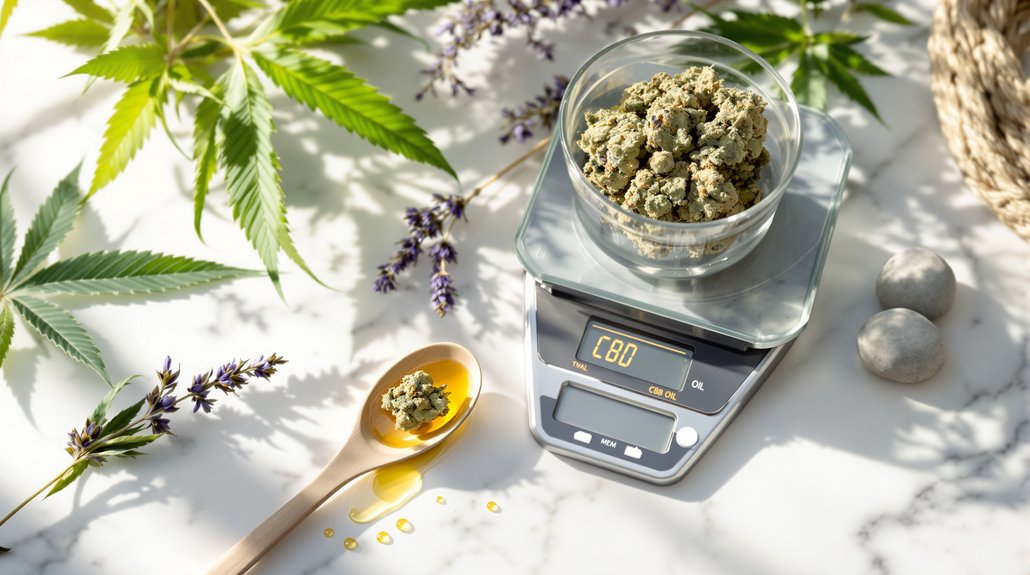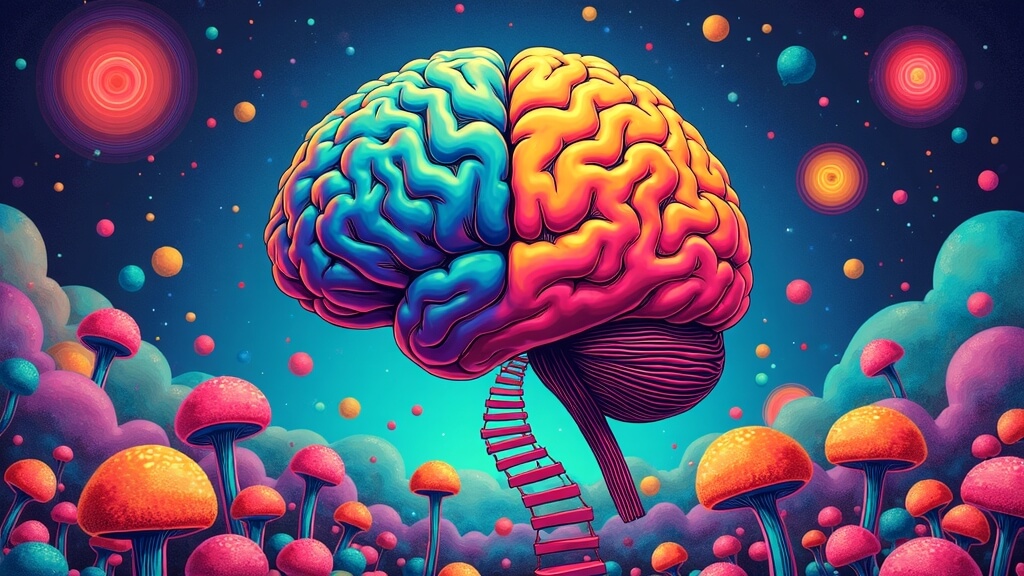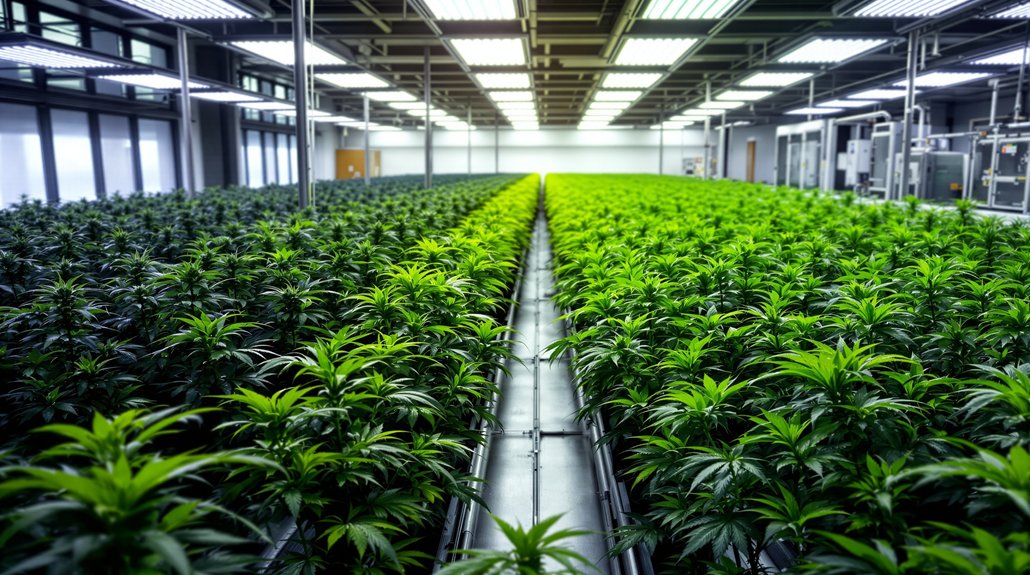The human body operates its own cannabis-like system long before anyone lights up. Scientists call it the endocannabinoid system, a vast network of receptors that naturally regulates everything from sleep cycles to pain perception. This internal chemistry set responds to both homegrown compounds and plant-based cannabinoids with surprising precision. Recent studies reveal how external cannabis molecules fundamentally hijack this ancient biological framework. The implications for targeted wellness applications are just beginning to surface, and the results challenge conventional thinking about natural healing.
The Endocannabinoid System: Your Body’s Natural Balance Network
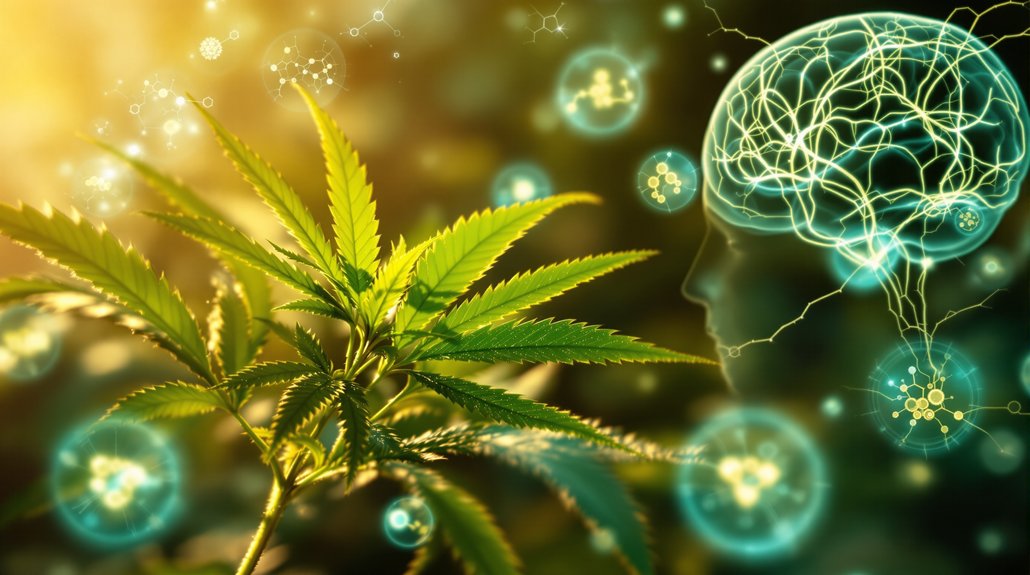
Every human body operates an intricate cellular communication network that most people have never heard of, yet it influences nearly every aspect of their daily experience.
The endocannabinoid system (ECS) functions as the body’s master regulator, maintaining internal balance through a sophisticated trio of components: naturally produced endocannabinoids, specialized receptors, and metabolic enzymes.
The ECS orchestrates vital bodily functions through endocannabinoids, receptors, and enzymes working in sophisticated harmony to preserve homeostasis.
Scientists discovered this remarkable system only decades ago, revealing its control over sleep patterns, appetite, pain sensation, mood regulation, and immune responses.
The network produces two primary signaling molecules on demand, anandamide and 2-arachidonoylglycerol, which bind to CB1 receptors in the brain and spinal cord, plus CB2 receptors throughout immune tissues.
ECS dysfunction appears linked to neurodegenerative conditions including Alzheimer’s and Parkinson’s disease.
Specialized enzymes like FAAH and MAGL rapidly break down these signaling molecules, preventing excessive activation. The ECS serves as a critical mechanism for maintaining homeostasis, automatically restoring balance when external disturbances like pain and fever threaten internal stability.
This discovery has opened new therapeutic avenues for researchers targeting pain, inflammation, and neurological disorders. The body can also interact with plant compounds like THCA derivatives, which offer potential anti-inflammatory and neuroprotective benefits without psychoactive effects until heated. Research indicates cannabinoids from cannabis sativa may help treat multiple sclerosis and various sleep disturbances.
THC vs CBD: Cannabis Compounds for Targeted Wellness
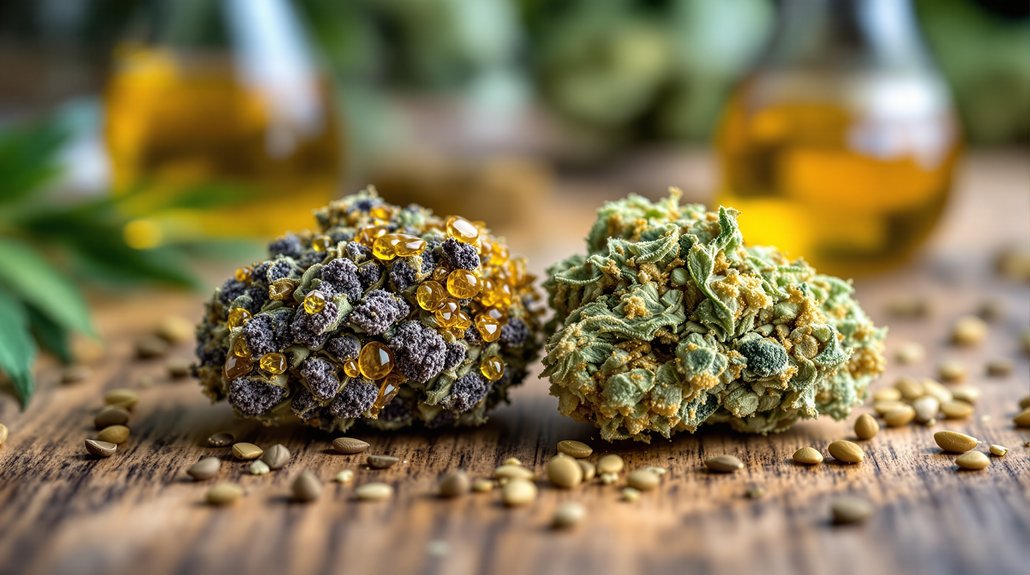
Cannabis contains over 100 different cannabinoids, but two molecular cousins dominate both scientific research and consumer interest. THC and CBD share identical molecular formulas while delivering dramatically different experiences.
THC binds directly to CB1 brain receptors, producing the signature cannabis high alongside appetite stimulation and pain relief. CBD takes a subtler approach, modulating these same receptors without intoxication while targeting anxiety, inflammation, and seizure disorders.
The medical applications paint distinct pictures. THC serves patients battling chronic pain, nausea, and appetite loss, often prescribed for severe conditions requiring robust symptom management. Before THC can deliver these effects, it must undergo decarboxylation process which converts the non-psychoactive THCA found in raw cannabis to psychoactive THC.
CBD has earned FDA approval for epilepsy treatment through Epidiolex, while showing promise for anxiety and neuroprotection. Smart formulations now combine both compounds, potentially offering synergistic benefits for multiple sclerosis and chronic pain.
Legal landscapes remain complex. THC remains federally controlled despite state-level legalization, while hemp-derived CBD enjoys broader acceptance, provided it contains less than 0.3% THC. Currently, 38 states have legalized medical marijuana programs alongside three U.S. territories and the District of Columbia.
Both compounds interact with the body’s endocannabinoid system, but individual responses vary significantly as not everyone experiences the same therapeutic benefits from these cannabinoids.
Mental Clarity and Mindfulness: Cannabis & Awareness
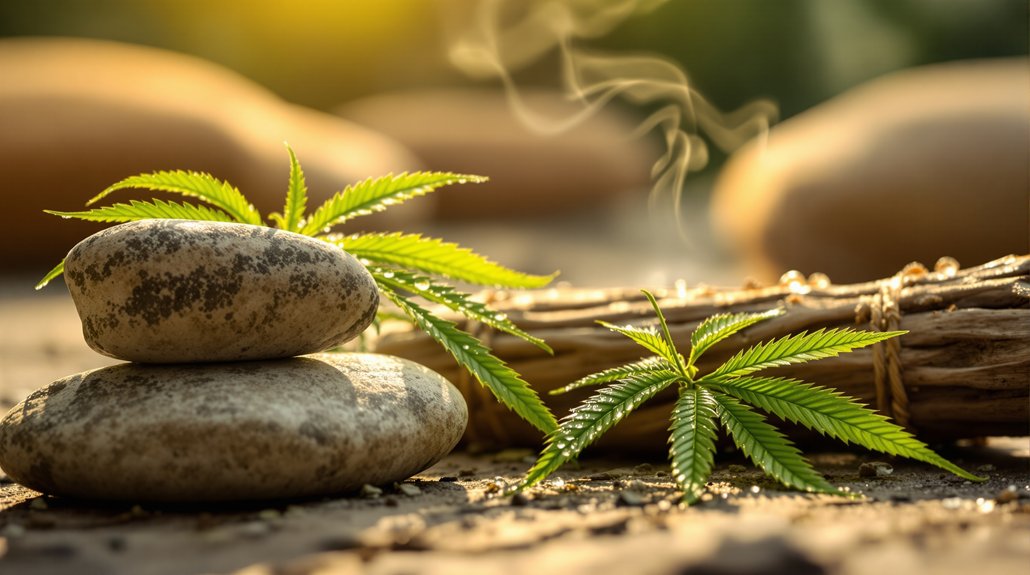
Meditation enthusiasts and cannabis advocates have long claimed that certain strains enhance mindfulness and present-moment awareness, yet scientific evidence paints a more complex picture. While users frequently report heightened sensory awareness and increased presence, clinical research remains insufficient to support these anecdotal claims definitively.
Despite widespread claims about cannabis enhancing meditation, rigorous scientific research has yet to definitively validate these popular anecdotal reports.
The reality proves more nuanced than marketing materials suggest. THC-dominant products typically increase distractibility and impair cognitive function, hardly ideal for focused meditation. Meanwhile, CBD-dominant varieties show minimal acute cognitive disruption in controlled studies, making them potentially better candidates for mindful practices.
Heavy cannabis users face a particular paradox, 63% show reduced brain activity during working memory tasks, with the dorsolateral prefrontal cortex taking the biggest hit. Near-daily use for over two years correlates with measurably lower scores in decision-making and executive function. Additionally, heavy cannabis users report higher rates of suicidal thoughts than nonusers, raising serious concerns about long-term mental health impacts.
Short-term cognitive changes, including altered time perception, remain temporary and dose-dependent. Individual responses vary wildly based on genetics and usage patterns. Recent research involving over 1,000 young adults used advanced brain imaging technology to assess how cannabis affects neural responses during cognitive tasks.
Emotional Balance: Can Cannabis Support Mood Regulation?

How effectively does cannabis actually influence emotional well-being beyond the euphoric haze of user testimonials? Research reveals a complex picture of short-term benefits with long-term complications.
Acute cannabis intoxication consistently produces more positive mood states and decreased anxiety levels in young adults. The endocannabinoid system modulates mood regulation by reducing stress hormone output, particularly cortisol, creating immediate relief from negative emotions.
However, these benefits appear largely subjective – users feel better without measurable improvements in actual emotion regulation skills.
The catch emerges with chronic use. Regular cannabis consumption can blunt the body’s natural stress response systems, creating neuronal adaptations that impair long-term stress management.
Individuals with poor emotion regulation increasingly rely on cannabis as a coping mechanism, potentially masking underlying problems rather than resolving them. Research involving 852 adults demonstrated that emotion dysregulation significantly moderates the relationship between stress and problematic cannabis use patterns.
While cannabis delivers genuine short-term mood stabilization, prolonged use may ultimately increase anxiety and depression risk. The emotional relief comes with neurobiological trade-offs that researchers are still unraveling. Notably, sex differences exist in cannabis effects, with females experiencing more intense cravings and physical withdrawal symptoms compared to males.
This complex relationship is reflected in global regulation, where over half the world now permits some form of medical cannabis use for treating various mood and anxiety disorders.

While social anxiety affects millions of adults worldwide, emerging research suggests cannabis may offer an unexpected pathway to meaningful human connection. THC appears to lower amygdala reactivity to social threat signals, effectively reducing the intimidation factor in social interactions. Users frequently describe cannabis as a social lubricant that facilitates deeper conversations and relaxed interactions, particularly in comfortable settings like private homes.
The endocannabinoid system plays a significant role in modulating emotional responses during social encounters. Research shows users often experience increased camaraderie and group connectivity, attributed to stress reduction and enhanced relaxation. Modern cannabis culture has cultivated inclusive communities that welcome diverse voices and perspectives across various demographics.
The body’s natural endocannabinoid network actively shapes how we emotionally process and respond to social situations and interpersonal dynamics.
However, context proves essential as familiar environments amplify these sociability effects, while unfamiliar or public settings can trigger anxiety instead. Adolescents prove particularly vulnerable to cannabis influence through peer networks, as close friends significantly impact individual use patterns through social modeling and direct pressure.
Cannabis enhances the perception of connectedness and group belonging in many users, fostering inclusion within social circles. The effects remain dose-dependent; mild use in accepting environments may improve group cohesion, while overuse can promote withdrawal and impair communication skills. Studies indicate that frequent marijuana use correlates with increased feelings of loneliness, highlighting the importance of moderation in cannabis consumption patterns.
Recovery and Anti-Inflammatory Benefits for Active Lifestyles
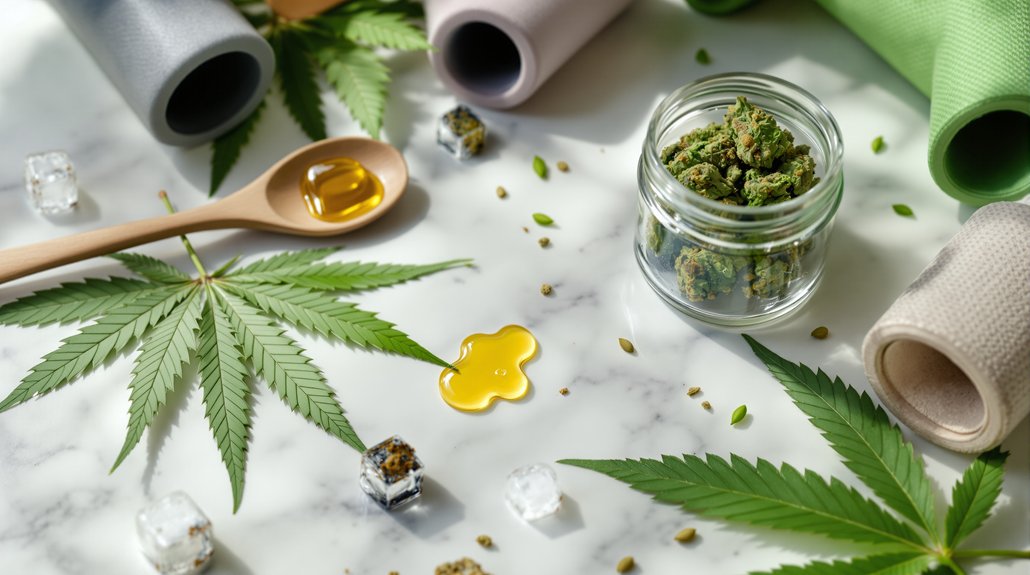
Millions of athletes and fitness enthusiasts are discovering that cannabis compounds may offer a natural alternative to traditional recovery methods, with emerging research suggesting substantial benefits for post-exercise healing.
CBD demonstrates notable anti-inflammatory properties by reducing pro-inflammatory cytokines in early human studies. This translates to less muscle soreness and faster tissue repair after intense workouts. Research shows 60mg CBD doses can meaningfully reduce muscle damage markers including creatine kinase and myoglobin within 72 hours post-exercise.
THC takes a different approach entirely. Randomized trials indicate THC and THC/CBD combinations greatly outperform CBD alone for immediate pain relief, though dosing matters, low amounts help while high doses backfire. Understanding THC bioavailability factors is crucial when developing effective recovery-focused edibles that deliver consistent relief.
Sleep quality improvements represent another recovery pathway. CBD reduces sleep onset time and boosts efficiency, indirectly supporting growth hormone release during vital nighttime repair phases.
Athletes report less post-exercise insomnia and restlessness. Professional rugby players are now participating in controlled studies that specifically examine cannabis effects on sports-related injuries and recovery patterns.
Interestingly, investigations comparing habitual cannabis users to non-users show no significant differences in overall aerobic fitness or physical performance metrics.
The research remains preliminary, but early indicators suggest cannabis could revolutionize athletic recovery protocols.
Mind-Muscle Connection: Cannabis in Fitness
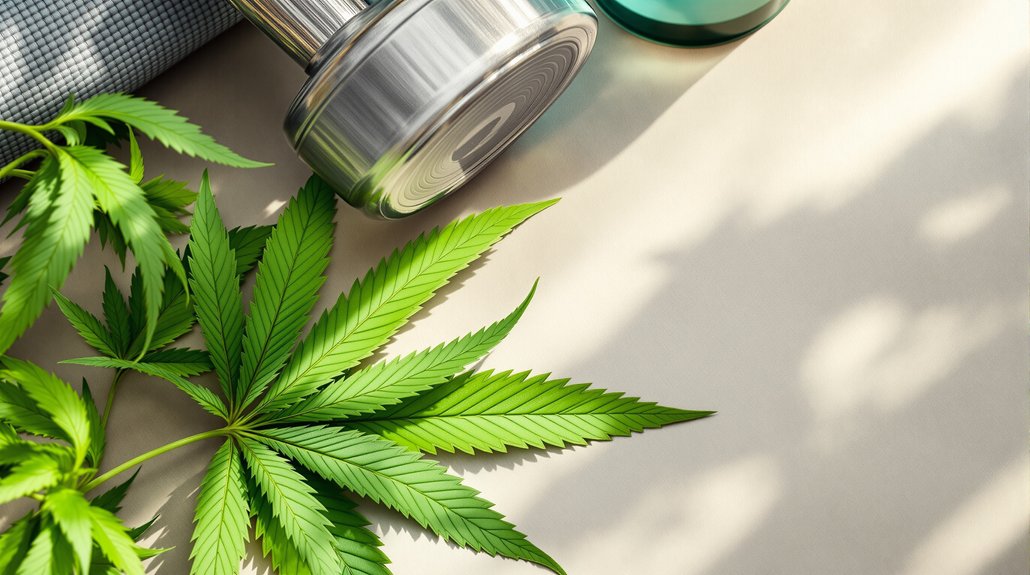
Beyond recovery benefits, cannabis appears to be reshaping how people experience movement itself, with emerging research revealing intriguing connections between cannabinoids and exercise enjoyment.
Studies consistently show cannabis users report higher motivation and adherence to workout routines compared to non-users. They describe exercise as more pleasant and fun, particularly with THC or CBD dominant products.
The phenomenon extends beyond simple enjoyment. Some athletes report heightened bodily awareness and enhanced mind-muscle connection during moderate cannabis use, though individual responses vary greatly.
Strain selection and dosage prove vital, low to moderate amounts more frequently link to perceived neuromuscular enhancement, while higher doses may impair coordination. When considering edibles specifically, timing is crucial as effects typically take 30 to 90 minutes to manifest and peak around 2-3 hours after ingestion.
Interestingly, cannabis may increase perceived exertion despite showing no impact on objective performance metrics like VO₂max or heart rate. This altered perception potentially influences pacing decisions during workouts. Research also suggests that cannabis users experience lower pain perception following exercise sessions, which may contribute to improved recovery and willingness to maintain consistent training schedules. A recent University of Colorado study found that participants experienced symptoms of runner’s high after cannabis use during treadmill exercise tests.
Meanwhile, weed workouts and cannabis yoga classes reflect growing community interest in merging cannabinoids with mindful movement practices.
Cognitive Considerations: Brain Function and Memory Effects
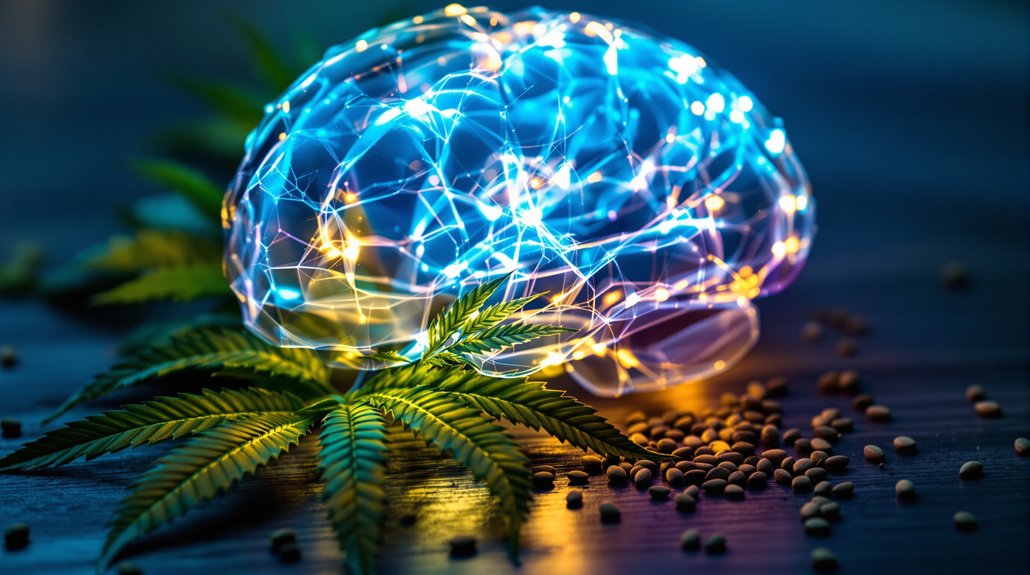
As cannabis gains mainstream acceptance for wellness applications, researchers are uncovering complex effects on cognitive function that extend far beyond the stereotypical stoner narrative.
Neuroimaging studies reveal that THC primarily targets the dorsolateral prefrontal cortex and anterior insula, brain regions dense with CB1 receptors. Heavy users show measurably reduced activation during memory tasks, even weeks after last use.
Heavy cannabis users demonstrate significantly reduced brain activation in memory-critical regions weeks after their last use, neuroimaging data confirms.
Working memory takes the biggest hit. THC disrupts synaptic plasticity in hippocampal regions, interfering with how memories encode and retrieve. Users consistently perform worse on verbal and working memory assessments compared to non-users.
The mechanics are straightforward: THC hijacks the endocannabinoid system, disrupting neurotransmitter release and cellular energy production. Chronic exposure reduces CB1 receptor density, creating lasting neural adaptations. Unlike THC, CBN metabolites can interact with these same systems but with approximately 75% less psychoactive potency.
Recovery varies dramatically. Short-term impairments often resolve within weeks of abstinence, but heavy users may experience persistent working memory deficits. Large-scale studies involving 1003 young adults confirm these cognitive patterns persist even after controlling for other substance use factors. Research using seven different fMRI tasks demonstrates that cannabis effects extend beyond working memory to influence multiple cognitive domains simultaneously.
Adolescent exposure carries higher risk for enduring cognitive changes, timing matters considerably for brain development.
Integrating Cannabis Into Holistic Wellness Routines
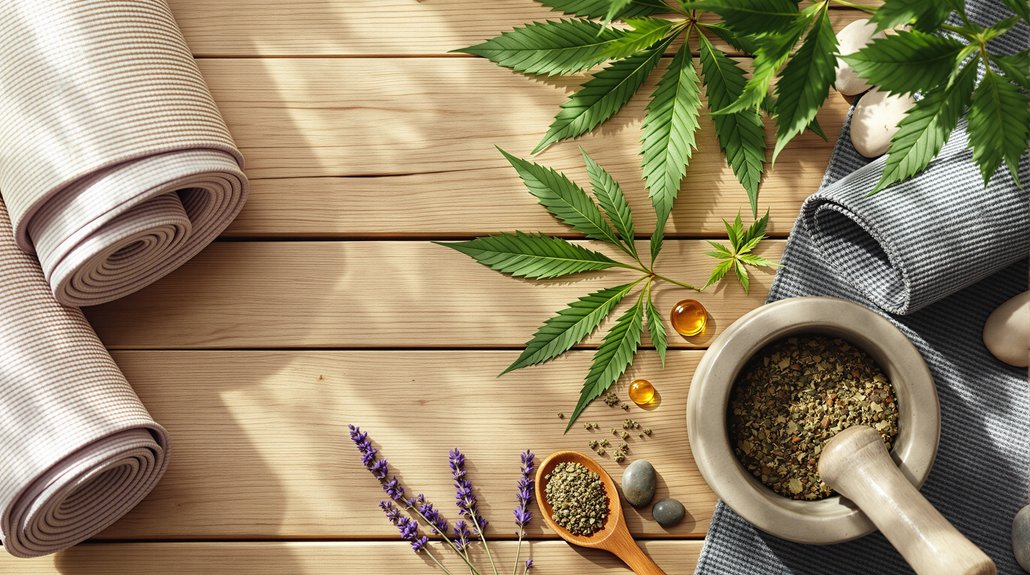
While cognitive effects present valid concerns for cannabis users, growing numbers of wellness practitioners are discovering strategic ways to incorporate cannabis into broad health routines that extend well beyond recreational use.
Athletes increasingly turn to topical cannabis products and transdermal patches for targeted workout recovery. Over 80% of cannabis-using athletes believe it assists with recovery and performance, according to 2021 research. CBD dominates this space for inflammation control and joint pain reduction.
The emotional wellness sphere sees CBD helping regulate mood and reduce overthinking. Moderate THC doses enhance sensory experiences and deepen interpersonal connections during social gatherings. Some users report improved participation in meaningful conversations. Therapists with cannabis knowledge can develop individualized treatment plans that address specific mental health needs alongside conventional therapeutic techniques.
Spiritual integration remains particularly intriguing. Cannabis enhances connections to nature and promotes self-compassion when paired with yoga or reflective journaling. Historical ceremonial use supports modern mindfulness practices. Many wellness enthusiasts create homemade edibles like cannabis gummies for controlled dosing and natural ingredient customization.
The key lies in strain selection, dosing, and timing. Medical marijuana users note increased energy and better physical functioning within three months when properly integrated into extensive wellness routines. Recent research tracking patients over 12 months found sustained improvements in quality of life, with particular benefits for anxiety, depression, and chronic pain management.
Dosage and Intention: Maximizing Benefits While Minimizing Risks
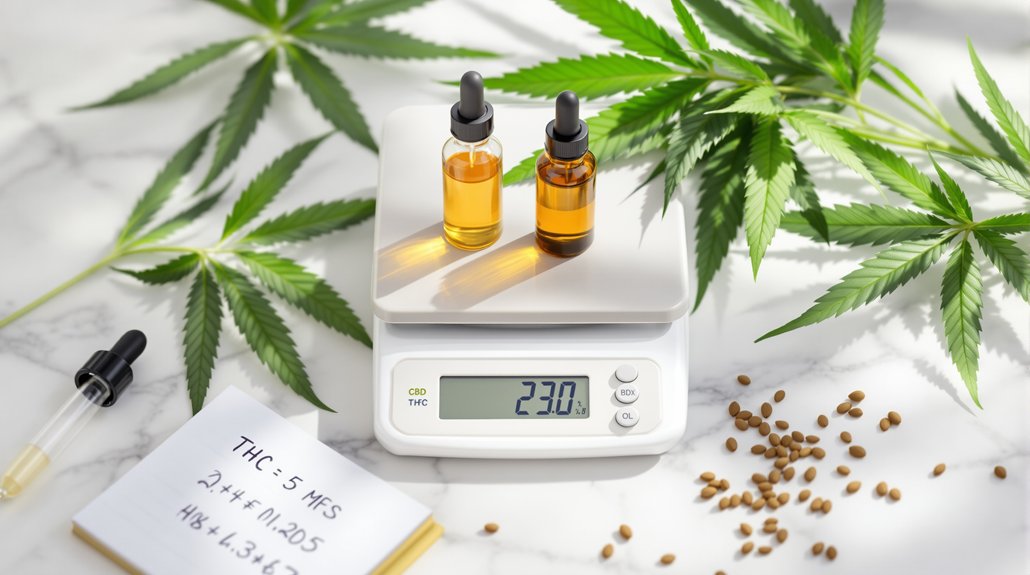
Success with cannabis wellness hinges on two critical factors that separate therapeutic users from recreational experimentation: precise dosing and clear intention setting.
The start low, go slow principle dominates medical cannabis protocols. CBD newcomers typically begin with 5 mg daily, gradually increasing by 5-10 mg increments every few days. THC requires even more caution, novice users start with just 1-2.5 mg weekly increases. These conservative approaches prevent the classic mistake of impatient users who jump to high doses and experience anxiety or unwanted intoxication.
Patient characteristics dramatically influence ideal dosing. The same 10 mg CBD dose that barely registers for a 200-pound construction worker might prove overwhelming for a petite senior citizen with multiple medications. Multiple small doses throughout the day may be more effective than one large dose. Individual metabolism speed significantly affects how long THC remains in your system, with faster metabolizers clearing the compound more quickly.
Strategic timing enhances results. Many users prefer CBD-dominant ratios during daytime hours for mental clarity, switching to THC-heavy formulations at night for sleep support. Medical cannabis shows promise for treating multiple pain types, including neuropathic, inflammatory, nociplastic, and mixed pain conditions.
